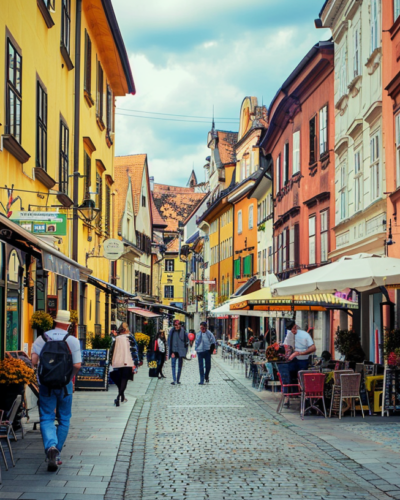Discover how innovative architecture is sculpting the cultural landmarks of the future, blending tradition with avant-garde aesthetics.

Innovative architecture is not only reshaping today’s skylines but also redefining our cultural landmarks for generations to come. As we gaze into the architectural future, it’s clear that the structures being erected are not merely buildings; they are bold statements of our era’s technological advancements and cultural evolution. After all, futuristic architecture is not just about sleek lines and shimmering facades; it’s also about creating spaces that resonate with the spirit of innovation and stand as beacons of progress.
These new cultural landmarks serve more than just aesthetical and revolutionary innovations but also environmentally conscious structures that represent a synergy between human creativity and ecological sensitivity. As you wander through these spaces, either in person or through the pages of this article, you’ll discover how futuristic design is pushing the boundaries of what a true architectural marvel can be. It’s a testament to our unyielding quest for growth and a preview of the wondrous world our descendants will inhabit.
Join us as we explore the cultural landmarks of tomorrow — structures that are sure to captivate your imagination and inspire awe with their groundbreaking approach to design and functionality.
The Guggenheim Museum Bilbao – Bilbao, Spain
Nestled within the heart of Bilbao, the Guggenheim Museum is a masterpiece that revolutionized the world of architecture. Its creator, Frank Gehry, designed a building that defies gravity with its swirling masses of titanium and glass, shimmering along the Nervión River. The museum’s form is a fluid juxtaposition of orthogonal blocks and curved volumes, creating an interactive play of complex, reflective light that changes with the day and weather. It’s a place where the boundary between the building and the art it houses blurs, making each visit an immersive, multi-sensory experience.
Inside, the museum unravels into a labyrinth of galleries, each offering a unique spatial experience that complements the modern and contemporary art it displays. The atrium, a colossal, light-filled space, acts as the organizing center from which the museum’s wings spread.
Gehry’s design philosophies are evident in the seamless flow between the interior and exterior, inviting the city into the museum and vice versa. The Guggenheim Museum Bilbao is not just a cultural landmark; it’s a beacon of futuristic architecture that speaks to the very soul of the city — inspiring a renaissance of urban transformation around it.

The Burj Khalifa – Dubai, UAE
Dominating the skyline of Dubai, the world-famous Burj Khalifa stands as a colossus of futuristic architecture. This towering edifice holds the title of the world’s tallest structure, a monument of superlatives that pierces the firmament of aesthetics and etches its place in history. The design, inspired by the desert flower Hymenocallis, is a fusion of cultural influences and cutting-edge engineering, resulting in a building that is both a marvel of technology and a work of art.
The Burj Khalifa represents a vertical city within itself, comprising residential spaces, offices, observation decks, and the Armani Hotel. Its triple-lobed footprint is an engineering feat that supports its sky-piercing height while reducing the impact of wind forces. With its Y-shaped plan, it maximizes views of the Persian Gulf and optimizes residential and hotel space. As night falls, the tower comes alive with a luminous facade that echoes the stars, a symbol of ambition and progress that has reshaped the concept of cultural landmarks across the globe. With other skyrises like the Burj Al Arab and Atlantis The Royal dotting the skyline, it is further elevated in a sea of city lights.
The Lotus Temple – New Delhi, India
The Lotus Temple in New Delhi is a sanctuary of serenity and a striking example of futuristic architecture. Its design, inspired by the lotus flower, encapsulates purity and peace, attracting visitors from all walks of life, irrespective of their faith. The structure is composed of 27 free-standing marble-clad petals arranged in clusters to form nine sides, with nine doors opening onto a central hall capable of holding up to 2,500 people.

The temple’s surface beautifully reflects the sky’s natural hues, while its interior is bathed in a soft, ethereal light that filters through the leaves. The water that surrounds the petals not only complements the design’s aesthetic but also works to moderate the temple’s microclimate. This cultural landmark is not only a place for worship but also an architectural wonder that represents a marriage between reverence for nature and technological advancement, making it a beacon of hope and unity in a rapidly changing world.
The National Museum of African American History and Culture – Washington D.C., USA
In the capital of the United States stands the National Museum of African American History and Culture, another global cultural landmark encapsulating centuries of history through its futuristic architecture. The building’s three-tiered structure, enveloped in a bronze lattice, pays homage to the intricate ironwork crafted by enslaved African Americans in Louisiana and South Carolina. This design element is both a protective skin and a visual narrative, capturing the strength and resilience inherent in African American culture.
The museum’s interior journey is as compelling as its exterior, with a narrative that guides visitors from the darkness of the lower levels, which detail the history of slavery, to the light-filled upper stories that celebrate African American culture and contributions. The museum stands as a testament to the community’s journey, an embodiment of hope, and a beacon of achievement in American architecture. Its presence on the National Mall challenges and redefines the identity of a cultural landmark for the future.

The Beijing National Stadium – Beijing, China
The Beijing National Stadium, more colloquially known as the ‘Bird’s Nest,’ is an emblem of China’s bold leap into modernity and its embrace of futuristic architecture. Conceived by architects Jacques Herzog and Pierre de Meuron for the 2008 Summer Olympics, this staggering edifice is both an ode to China’s cultural heritage and a beacon of its future aspirations.
Its interlocking steel framework, which creates the appearance of a bird’s nest, is not just visually compelling but also a marvel of engineering. The design breaks away from traditional enclosed stadiums, instead presenting an open and inviting form that breathes with the city’s life, symbolizing openness and accessibility. As a prime cultural landmark, the stadium has hosted significant events beyond the Olympics, from sporting fixtures to concerts, embedding itself into the social fabric of Beijing.
Its legacy is twofold: a reminder of the city’s historical moment on the global stage; and as a canvas for communal experiences for years to come. The stadium’s night-time illumination transforms it into a glowing lantern, a lighthouse guiding Beijing’s foray into the night. It’s a physical manifestation of the transformative power of light and shadow, where architecture becomes an interactive element of the urban landscape.
Learn More About Cultural Landmarks Around the World with This City Knows
As we journey through these cultural landmarks, each with its unique narrative and architectural splendor, we invite you to continue the exploration with This City Knows. Our platform is dedicated to unveiling the stories behind the most awe-inspiring cultural landmarks across the globe. Whether you’re an avid traveler or an armchair explorer, This City Knows offers a window into the world’s most innovative and culturally significant landmarks.
Uncover the secrets of futuristic architecture and the masterminds behind them, and be inspired to witness these marvels in person. Discover, plan, and embark on a journey that transcends time and space. With This City Knows, your next adventure into the world of cultural landmarks is just a click away!








